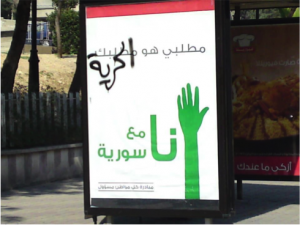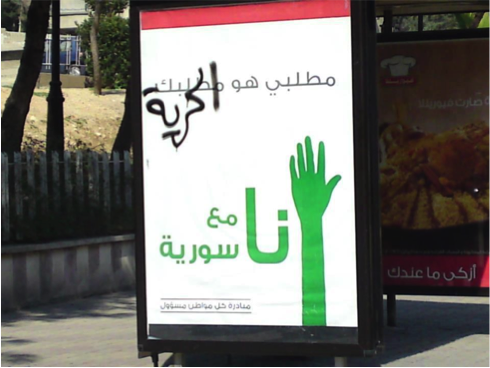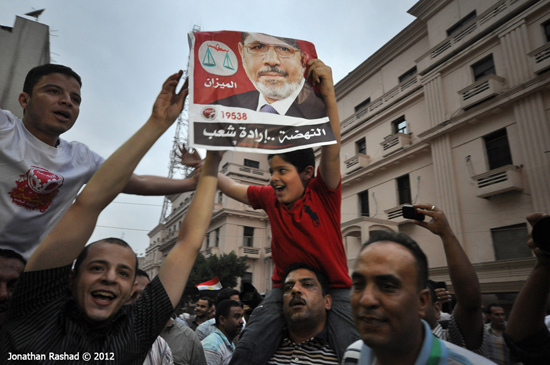The Syrian uprising is not merely an armed struggle between regime forces and different opposition groups, as the mainstream media and politicians describe it. When looking closer at the uprising, something becomes clear; there is also a cultural struggle with words as the primary weapon in music, literature, humor, slogans and theatre that is taking place on both sides. Opposition groups define this cultural struggle symbolically by saying they have been “breaking the wall of fear.” This means that they are able not only to mock President Bashar al-Assad openly, but also to challenge the regime on words and terminology, over which the regime has held a monopoly for decades. At the same time, the regime is struggling to maintain its dominance in the public sphere by punishing artists, poets and musicians while using regime-controlled areas to spread pro-regime propaganda campaigns.

A brief historical background on cultural production within Syria shows how opposition groups have succeeded in “breaking the wall of fear” by using culture as a tool of defiance against the regime. This narrative is combined with the regime responses to this oppositional culture and its efforts to maintain its cultural dominance, helping to present the broader picture of this creative uprising.
“Culture is humanity’s highest need.” – Despite the rather democratic notion of the sentence, a quote from late Syrian president and Bashar al-Assad’s father, Hafiz al-Assad, in 1984,[1] it also shows how the Syrian regime has controlled the flow of culture, including critical culture, for decades. By acknowledging that culture is humanity’s highest need, the quote reveals that the control of culture is essential for an authoritarian regime in order to maintain power. By knowing that culture is essential, it can also be used as a tool to shape the regime’s own ideology and narrative. Thereby, the regime is supporting culture in order to use it and, as Havel puts it, is “straightening it’s crookedness into the cult.”[2]
The regime tolerates some criticism instead of “choking” it all and uses it in order to appear democratic, both regionally and internationally:
“Commissioned criticism … it is the regime’s Machiavellian manipulation of dissidence. The state pressures dissidents to continue their dissident practice … The state [then] tries to coopt the criticism … Commissioned criticism is a state-sponsored practice that performs official accountability for the rosy rhetoric of slogans while attempting to convert real dissident practice into state ideology.”[3]
This Machiavellianism in Syria is seen through the distribution of books. For instance, a book is very likely to be pressed and published by the Syrian Ministry of Culture. However, it will only be showed at regime sponsored international book fairs, and will be almost impossible to buy inside Syria. This is a method used by the regime to present a façade to the world: that Syria is a nation based on free and democratic principles.[4]
Nevertheless, forms of culture critical of the regime exist inside Syria. But yet again, it is twisted or straightened by the regime to favor the government. This is done by allowing criticism that is so obvious in the society that the regime cannot deny it. However, criticism of the president and his family is prohibited in state-recognized culture. Such criticism is allowed through theater, where the regime licenses criticism and gives the people a breathing space that allows them to let go of their frustrations by “letting out air” – better known as “tanfis” in Arabic. Professor of political science Lisa Wedeen explains this as being licensed parodies of political power. [5]
Another noticeable result of the regime’s cultural monopoly is seen through the omnipresent symbolism in the public sphere, especially concentrated on the al-Assad family, its many attributes and sometimes even godlike prominence. Wedeen describes this in detail:
“In official Syrian political discourse, President Hafiz al-Asad is regularly depicted as omnipresent and omniscient. In newspaper photographs he appears as the ‘father,’ the ‘combatant,’ the ‘first teacher,’ the ‘savior of Lebanon,’ the ‘leader forever,’ or the ‘gallant knight,’ a transparent reference to the modern-day Salah al-Din. … Religious iconography and slogans attesting to his immortality bedeck the walls of buildings, the windows of taxi cabs, and the doors of restaurants.”[6]
From my own experience of travelling inside Syria in July 2011, the omnipresence of the former president in the public sphere continued after Hafiz al-Assad’s death, with his son depicted as “the doctor,” “the general,” and the “prominent figure.”
This cult around the president and his family’s persona is also used as a part of the regime’s strategy to maintain dominance, which is based on the Syrian citizens’ discipline and obedience rather than the legitimacy of the regime. This means in practice that the population is expected to show support through slogans and participation in public events, such as sport events and “sudden” protests honoring the president, even though they may not support the regime. The individual motive for this obedience can be explained as a subjective choice based on cost-benefit for the individual. Slovenian Marxist and cultural critic, Slavoj Zizek argues:
“[That] the only real obedience … is an ‘external’ one: obedience out of conviction is not real obedience because it is already ‘mediated’ through our subjectivity – that is, we are not really obeying the authority, but simply following our judgment, which tells us that the authority deserves to be obeyed in so far as it is good, wise, beneficent.”[7]
The Syrian people are fluent in the regime’s rhetoric and act as if they support it.[8] They do this because it is beneficial at the individual level. The result of the Syrian people acting as if they support regime is the population exercising what Czech dissident Vaclav Havel refers to as “the principle of social auto-totality.” Citizens impose obedience and loyalty upon themselves and each other in the public sphere,without actually believing in it.[9] This ultimately leads to reproduction of obedience to the regimes ideology in the public sphere.[10] However, there have been significant changes to this obedience in the wake of the Syrian uprising, including massive campaign ridiculing of the regime and Bashar al-Assad.
The first example of a change in Syrian obedience is “the raised hands campaign.” This campaign was initiated by the regime after March 15, 2011.[11] It includes a series of posters and huge billboards all over Damascus, featuring a raised hand with the following Arabic text: “Whether [young; progressive] … or [old; conservative] … I’m with … [the law; Syria]” The campaign symbolized the unity of the Syrian people, or rather, the regime’s discourse of unity. This campaign also showed the regime’s continuous efforts to dominate the public sphere and keep regime rhetoric intact, by employing “[some] sort of Orwellian atmosphere, a sort of ‘Big Brother’ watching citizens and reminding to comply with the law.” However, opposition activists turned this campaign to their favor by reformulating the slogans or making new ones, both on the streets and by making “posters” online and sharing them on social media. This peer production using mash-ups, jokes, and slogans can be seen as an emergence of active citizenship in which citizens enable themselves to define their own beliefs, history, and meaning of words such as “law” or “freedom.” This nature of peer production is not only restricted to opposition activists; pro-regime activists are also engaging in this process.[12]
Whereas the above case shows the activists’ attempt to reformulate or “remix” the regime’s discourse and therefore challenge the dominant ideology, a second case shows in some ways the opposite; how the regime acts on this dissident culture. Several incidents show that the regime does not accept this form of criticism. This becomes evident when analyzing the work of caricaturist Ali Ferzat, whose hands were symbolically beaten and bruised by pro-regime forces after he started publishing caricatures of the president.[13] Another more gruesome incident is the case of the poet Ibrahim Qashoush, whose body was found in the Orontes River near Hama with his throat cut.[14] Such a symbolic act, possibly by regime loyal forces, warned other creative activists against mocking the president. However, it is clear that this brutal crackdown has not stopped creative activists in their dissident activities as it is seen both online with the puppet theater “Top Goon”[15] and on the streets in Kafr Nabl.[16]
The significance and relevance of cultural resistance in Syria is crucial to defining the scope of this form of resistance in the Middle East at large. This is exactly what the creative arts are providing information about. By using humor, theatre, literature and art they successfully allow for the expression and discussion of what they as ordinary citizens, outside of the political sphere, think about abstract concepts such as “freedom” or “citizenship.” They do so with renewed confidence and without fear within a framework they can relate to, rather than in a broad political sense.[17]
Governments and NGOs in the Netherlands, Norway, Denmark, and England are already openly supporting Syrian opposition groups, by both funding and displaying their art in exhibitions focusing on the subject.[18] Engagement with these artists and authors through official funding, support and recognition could be a part of a long-term strategy with potentially beneficial results for the main US- and international interest in the region: stability. Such support will show the Syrian people that the international community is interested in letting the Syrians determine and discuss their own future actively and peacefully, without foreign powers openly supporting a specific group or party.
It is wrong to assume that the Syrian uprising is merely an armed conflict in which factions are struggling to gain or regain power and dominance. The Syrian conflict is also an ideological conflict, which includes a cultural uprising struggling against the dominant state cultural narrative. Ordinary citizens are using their creativity in a completely new way — to express their discontent toward the state, current societal norms, as well as their hope for a new and better Syria — in a manner never seen before in the country.
By using creativity as a tool against the regime, activists are breaking the “wall of fear” and turning themselves from subjects into citizens by redefining concepts and thereby challenging the regime on its core ideology, its dominance in the public sphere, and its framing of history and culture.[19] It shows that the Syrian people want to be able to express themselves freely without being punished by the state, and that they want to hold their leaders accountable for their crimes and inability to rule the country. This discourse is important for observers to consider when discussing the future of Syria in a larger context.
As most of these cultural acts of defiance seem to be secular in their ideology, is it important for the West to support these and encourage opposition groups in their struggle for a better Syrian future. This can be done, as seen with many European countries, through exhibitions and funding of cultural projects. The outcome of supporting these groups and artists may provide opportunities, outside of the political sphere, for a free debate among ordinary Syrians where they can discuss ongoing events and the future of their country in a peaceful manner.
References
[1] Miriam Cooke, Dissident Syria: Making Oppositional Arts Official [2007], 1st. ed. (Durham: Duke University Press), p. 27
[2] Ibid. p. 35
[3] Ibid. p. 73
[4] Ibid. p. 74
[5] Lisa Wedeen, Ambiguities of Domination: Politics, Rhetoric, and Symbols in Contemporary Syria [1999], 1st. ed. (Chicago: The University of Chicago Press), s. 88 & Cooke, Dissident Syria, p. 72
[6] Ibid. p. 1
[7[ Ibid. p. 73
[8] Ibid. p. 6, 40, 92 & Cooke, Dissident Syria, p. 23
[9] Lisa Wedeen, Ambiguities of Domination, p. 75
[10] Ibid. p. 92
[11] March 15, 2011 (Day of Rage) is recognized as the start date of the Syrian Uprising. See Marc Lynch, The Arab Uprisings: The Unfinished Revolu New Middle East [2012], 1st. ed. (New York: Public Affairs), s. 118, 181
[12] Donnatella Della Ratta, Syrian Hands Raised: User Generated Creativity Between Citizenship and Dissent [October 2013], jadaliyya.com
[13] Nour Ali, Syrian Forces Beat Up Political Cartoonist Ali Ferzat [August 2011], theguardian.com
[14] Bassem Mroue, Songwriter of Syria Uprising Meets Gruesome Dead [July 2011], dailystar.com.lb
[15] Top Goon YouTube Channel: http://www.youtube.com/user/MasasitMati & Tim Hume, Syrian artists fight Assad regime with satire [August 2013]
[16] Occupied Kafr Nabl: http://www.occupiedkafranbel.com/
[17] Srdja Popovid & Mladen Joksic, Why Dictators Don’t like Jokes [April 2013], Foreignpolicy.com
[18] Forlaget Korridor (The Publisher Corridor,) Art in Exile, http://forlaget.korridor.nu/Art-in-Exile-Program & David Batty, Syria art smuggled from the midst of civil war to show in London [June 2013], theguardian.com
[19] Roschanack Shaery-Eisenlohr, From Subject to Citizens?, Middle East Critique (Vol. 20, Iss. 2, 2011) p. 137



